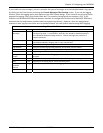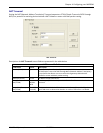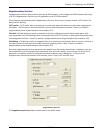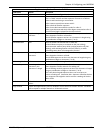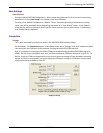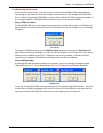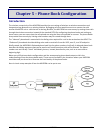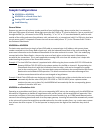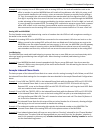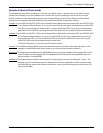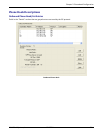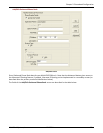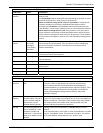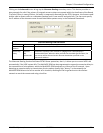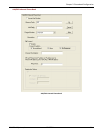
Chapter 5: Phonebook Configuration
Multi-Tech Systems, Inc. MVPGSM 54
Example 3: Your company has an IP PBX system with an analog VOIP unit for local calls and direct calls to the
office in another city and an MVPGSM that will handle all long distance calls. With this setup, a call
control module handles the call routing – when an extension requests an outside line (by dialing a
“9” first, for example) the call control module then watches what the first digit after the 9 is. If that
first digit is anything other than one of the local area codes, the call is routed through the MVPGSM
to take advantage of the cost savings provided by the wireless network. If the first digit is a local call,
it is sent through the standard PSTN. The analog VOIP could also be setup to connect with a remote
office VOIP as well. In this case then, there would be another access digit (an “8” for example) to
have an extension use the analog VOIP and connect to the remote location as if it were a local call.
Analog VOIP and MVPGSM
The Any Number setup entails determining a series of numbers that the VOIP unit will recognize as needing to
be routed to the remote VOIP.
Example 4:
An analog VOIP and an MVPGSM are connected to the same network. Calls that are local or on the
PBX are routed by the analog VOIP, while calls that are dialed out of the local area are sent to the
MVPGSM to use the wireless network and save money. In this case, the MVPGSM is the SIP gateway
to the wireless network. Incoming calls to the MVPGSM from an external source will receive the
auto attendant and from this, external calls can access the extensions attached to the analog VOIP.
Load Balancing
The MVPGSM uses round robin load balancing to ensure that one or more SIMs are not used excessively while
others go largely ignored during times of light traffic. When Hunting is enabled, load balancing is done
automatically.
Example 5:
Your MVPGSM has both channels populated with Pay-as-you-go SIM cards. You do not want the
Channel 1 SIM to carry the majority of the traffic while channel 2 sits idle waiting for channel 1 to be
busy so that it is used.
Example Inbound Phone Books
The basic purpose of the Inbound Phone Book is to create rules for routing incoming IP calls. Below you will find
the Inbound Phone Book settings for the examples that were detailed in the sample Phone Book Configurations
above.
Example 1:
Local VOIP has 763-555-4321 in the Inbound Phone Book while the Remote VOIP has 612-555-1234
in the Inbound Phone Book. A user at the Local VOIP can dial 612-555-1234 and it will ring the
Remote VOIP, a user at the Remote VOIP can dial 763-555-4321 and it will ring the Local VOIP. Both
calls are treated as local area code calls.
Example 2:
Local VOIP has 763-555-4321 in the Inbound Phone Book while the Remote VOIP has 612-555-1234
in the Inbound Phone Book. A user at the Local analog VOIP can pick up an attached phone and it
will ring the Remote GSM VOIP. The call is treated as a local area code call. The Auto-Call feature is
set in the Voice Parameters section.
Example 3:
The Inbound Phone Book for this setup will be set to Any Number for all channels, allowing all digits
and relying on the call control module to handle the routing.
Example 4:
The outbound number on the analog side matches the inbound number on the MVPGSM. The
Inbound Phone Book of the analog VOIP will list the phone number of the MVPGSM.
Example 5:
Your Inbound phone book will have one entry that has “Hunting” selected for the ‘Channel Number’
selection box. The other fields will be populated per your setup, but the ‘Any Number’ selection is
used in this example to allow any call, all other entries here must have ‘Hunting’ enabled as well to
use the load balancing feature.



